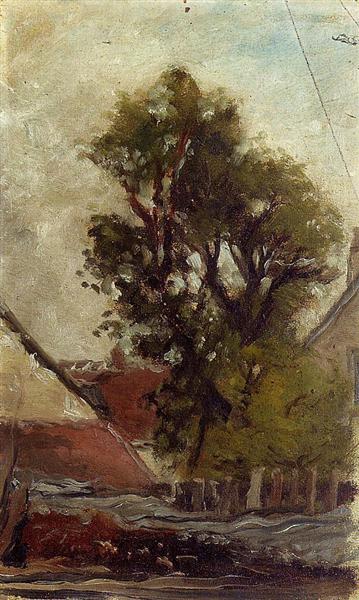תיאור
Paul Gauguin's Tree in the Farmyard, painted in 1874, is a fascinating example of the artist's early exploration of the depiction of the natural world and its interaction with the human environment. Through this work, Gauguin begins to lay the groundwork for his distinctive style, characterized by bold use of color and a composition that moves away from the strict naturalism that predominated in his time.
In the painting, the central element is an exceptionally robust tree that occupies a prominent position in the picture. Its thick, twisted trunk stands almost in the center, while the leaves spread out in a dense canopy of vibrant greens that contrast with the more subdued background of the rural landscape. This tree is not only a symbol of living nature, but also acts as a visual beacon that guides the viewer’s gaze and emulates the intrinsic relationship between plant life and agricultural space that frequently occupied Gauguin’s attention.
The palette used in Tree in the Farmyard reflects Gauguin's preference for saturated, contrasting colors. The cool greens of the foliage and the brown of the trunk stand out against a more faded brown background, where textures are intertwined with shades of blue and touches of yellow. This color choice suggests not only the closeness of nature to everyday life, but also an almost idealized vision of rural life, a theme that would resonate strongly in his later work.
In terms of the human figure, the painting lacks prominent characters, which is emblematic of Gauguin’s focus on connection with nature over human activities. However, a small building can be glimpsed behind the tree, suggesting the presence of a farm, an aspect that anchors the work in an agricultural context. This deliberate absence of human figures can be interpreted as a quest to highlight the serenity of the natural environment and the simplicity of country life.
"Tree in the Farm Yard" is set in a formative period for Gauguin, who, still under the influence of Impressionism, began to experiment with more symbolic forms of expression that would lead to his later Post-Impressionist style. His focus on light and color, as well as his quest to convey a sense of place and atmosphere, are legacies that endure in his later work in Tahiti, which would be characterized by a deeper symbolic intensity.
Within this context, the tree takes on an additional meaning: it could be a representation of life, stability and connection to one’s roots, both literally and figuratively, at a time when his career was beginning to take shape. Through this and other works of his time, Gauguin lays the groundwork for a pictorial language that would ultimately challenge the conventions of the art of his time, leading him to become one of the most influential figures in modern art.
In conclusion, Paul Gauguin's Tree in the Farmyard is a profound and introspective look at the natural world around the artist, and at the same time, a manifestation of his stylistic evolution. Every nuance of color and every deliberately placed shape reflects not only his technical mastery, but also a persistent desire to explore the human relationship with nature, a theme that would remain central to his work throughout his life.
KUADROS ©, a famous painting on your wall.
Hand-made oil painting reproductions, with the quality of professional artists and the distinctive seal of KUADROS ©.
Painting reproduction service with satisfaction guarantee. If you are not completely satisfied with the replica of your painting, we will refund 100% of your money.

